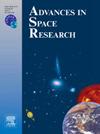Did the “Tauktae” cyclone impact the upper atmosphere through traveling ionospheric disturbances? A case study over the Arabian Sea using measurements from InSWIM network stations
IF 2.8
3区 地球科学
Q2 ASTRONOMY & ASTROPHYSICS
引用次数: 0
Abstract
In May 2021, the Arabian Sea experienced Cyclone Tauktae, the first pre-monsoon tropical cyclone of the year and the fifth strongest ever recorded over the Arabian Sea. It originated from a depression near the Lakshadweep Islands on May 14, 2021, rapidly intensified into an extremely severe cyclonic storm by May 17, 2021, and made landfall on May 19, 2021. During its passage, the Arabian Sea experienced highly convective and disturbed conditions. We used this powerful tropical cyclone amid geomagnetically quiet conditions to explore its potential effects on the ionospheric region. Using the COSMO regional atmospheric model, we simulated the movement of Cyclone Tauktae and lower atmospheric conditions. Additionally, we utilized ionospheric data from Kavaratti, GMRT, and Pune to investigate the possible impacts of cyclonic storms on the upper atmosphere. These three stations were selected from the Indian Network for Space Weather Impact Monitoring (InSWIM) network. Analysis of the Vertical Total Electron Content (VTEC) measurements from May 14 to 18, 2021 (cyclone-influenced days) and May 05, 2021 (non-cyclone day) revealed a prominent presence of Traveling Ionospheric Disturbances (TIDs) during the cyclone days. Spectral analysis of TEC data showed significant TID spectral power enhancements ( 5) on May 16–17, 2021, at Pune and GMRT, with wave velocities ranging from 100 to 125 m/s. As the geomagnetic conditions remained quiet during both the non-cyclone day and the cyclone-influenced days, the observed TIDs are attributed to the forcing from the lower atmosphere, eventually associated with the presence of Cyclone Tauktae.
求助全文
约1分钟内获得全文
求助全文
来源期刊

Advances in Space Research
地学天文-地球科学综合
CiteScore
5.20
自引率
11.50%
发文量
800
审稿时长
5.8 months
期刊介绍:
The COSPAR publication Advances in Space Research (ASR) is an open journal covering all areas of space research including: space studies of the Earth''s surface, meteorology, climate, the Earth-Moon system, planets and small bodies of the solar system, upper atmospheres, ionospheres and magnetospheres of the Earth and planets including reference atmospheres, space plasmas in the solar system, astrophysics from space, materials sciences in space, fundamental physics in space, space debris, space weather, Earth observations of space phenomena, etc.
NB: Please note that manuscripts related to life sciences as related to space are no more accepted for submission to Advances in Space Research. Such manuscripts should now be submitted to the new COSPAR Journal Life Sciences in Space Research (LSSR).
All submissions are reviewed by two scientists in the field. COSPAR is an interdisciplinary scientific organization concerned with the progress of space research on an international scale. Operating under the rules of ICSU, COSPAR ignores political considerations and considers all questions solely from the scientific viewpoint.
 求助内容:
求助内容: 应助结果提醒方式:
应助结果提醒方式:


